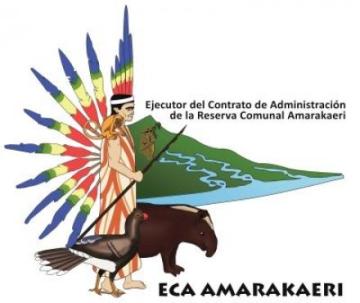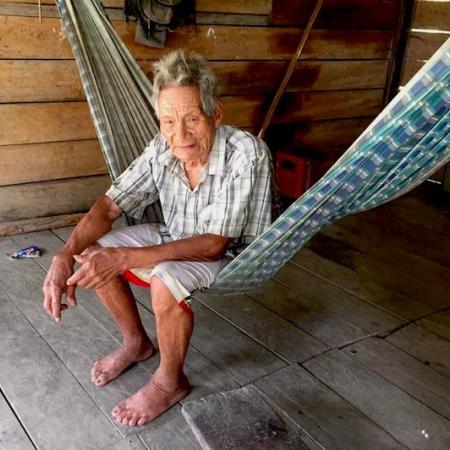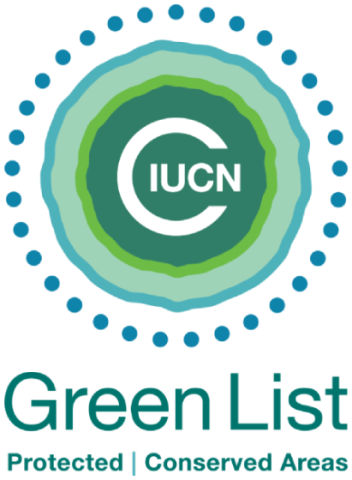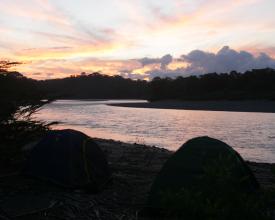
La confiance, clé de l'efficacité de la coopération entre l'État et les communautés autochtones dans la réserve communale d'Amarakaeri (RCA)

REDD+ est un mécanisme de réduction des émissions dues à la déforestation et à la dégradation des forêts, qui encourage l'inclusion de mesures de protection environnementales et sociales, en tenant compte de la participation pleine et effective des populations autochtones et des communautés locales. Au Pérou, des initiatives REDD ont vu le jour sans tenir compte des organisations autochtones. L'AIR est donc devenue une stratégie d'atténuation, d'adaptation et de résilience face au changement climatique, qui contribue à la conservation des forêts dans les territoires autochtones (60 % du territoire péruvien sont des forêts). Les communautés indigènes disposent de 11,5 millions d'hectares où se produit 16,5 % de la déforestation. Les réserves communales constituent une stratégie de conservation de la biodiversité au profit des populations locales. En 2012, le COICA et l'AIDESEP proposent une AIR pilote dans la RCA, où vivent les ethnies Harakmbut, Yine et Machiguenga, afin de renforcer la gouvernance, de canaliser les fonds climatiques et de contribuer à la réduction des émissions dues à la déforestation.
Contexte
Défis à relever
Social
- Consolidation d'une bonne relation entre les organisations autochtones et l'État péruvien afin de promouvoir des systèmes de vie saine pour les populations autochtones et de s'articuler avec les objectifs et les compromis nationaux et internationaux, en garantissant la conservation de la biodiversité, des forêts et des divers services écosytémiques.
- Élaboration et définition de principes et de mécanismes orientés vers une gouvernance entre les acteurs impliqués dans l'AIR dans le cadre d'un contrat d'administration autochtone.
Environnement
- Élaboration de la ligne de base pour les diverses fonctions écosystémiques. Il est fondamental de définir cette information car il faut aligner les niveaux de référence sur la déforestation et la dégradation au niveau national.
- Révision et articulation des protocoles de surveillance, de rapport et de vérification autochtones et de surveillance du programme national de conservation des forêts pour l'atténuation du changement climatique.
Economie
- Formulation d'une proposition technique - financière avec une approche RIA.
Emplacement
Traiter
Résumé du processus
Les réserves communales sont créées pour préserver la biodiversité et les valeurs culturelles des populations indigènes, en vertu d'un mécanisme de participation. Depuis 2005, un régime spécial régit l'administration et la gestion entre le SERNANP et les communautés bénéficiaires, organisées en Ejecutores de Contratos de Administración (ECA). Un contrat établit les responsabilités partagées entre le SERNANP et l'ECA pour la gestion participative et la conservation de la biodiversité. Pour les consolider, il est nécessaire de renforcer les capacités techniques, institutionnelles et communicationnelles, ainsi que l'articulation multi-acteurs et multi-niveaux. En vue d'une participation pleine et effective des populations autochtones et face au réchauffement climatique, l'AIR devient une stratégie de lutte contre le changement climatique qui contribue à la conservation des forêts dans les territoires autochtones. L'AIR dans la RCA est une expérience de gestion innovante, basée sur une approche de l'administration autochtone et de l'État, qui contribue à la réduction des émissions, mais surtout à la sécurité et à la consolidation du territoire intégral et collectif, à la mise en œuvre des plans de vie des communautés autochtones et à la mise en œuvre du Plan Maestro dans le cadre de l'AIR.
Blocs de construction
REDD+ Indígena Amazónico (RIA) dans le cadre d'un contrat d'administration autochtone
L'AIR est la stratégie de lutte contre le changement climatique qui contribue à la conservation des forêts dans les territoires autochtones. Avec l'appui des organisations autochtones, du SERNANP et d'autres ONG, un projet pilote a été lancé en 2012 dans le domaine de l'AIR. Sous l'égide de la CEA-RCA, du SERNANP et des organisations autochtones, les bases de la mise en œuvre ont été élaborées de manière participative. Ainsi, les acteurs orientés vers les mesures d'atténuation, d'adaptation et de résilience au changement climatique ont contribué à la mise en œuvre des plans de vie normale (planification stratégique des communautés autochtones), articulés autour du Plan Maestro et des lignes directrices de l'AIR : la sécurité et la consolidation du territoire intégral et collectif ; les plans de vie et le Plan Maestro avec un accent sur l'AIR ; la gouvernance, les accords institutionnels et la durabilité financière.L'AIR dans la RCA se consolide par le biais de : l'accord entre le SERNANP et la CEA-RCA, COHARYIMA, FENAMAD et AIDESEP ; l'avenant au contrat d'administration de la CEA-RCA pour faciliter la mise en œuvre des projets de rétribution des services écosystémiques ; et l'incorporation au Plan Maestro, à l'Estrategia Nacional de Cambio Climático, et à la mise en œuvre des fonds climatiques. Sa réplique dans les réserves communales et les communautés naturelles (4,5 millions d'hectares) revêt une grande importance.
Facteurs favorables
- Des aides conjointes pour surmonter l'obligation de modifier un contrat d'administration entre l'État et l'exécuteur du contrat d'administration, représentant de 10 communautés indigènes, pour la mise en œuvre de l'AIR.
- Soutien du COICA, de l'AIDESEP, de la FENAMAD et du COHARYIMA dans les espaces nationaux et internationaux pour présenter les avancées de l'AIR dans la RCA.
- Révision et approbation des documents de planification pour la mise en œuvre de l'AIR sous la forme d'un contrat d'administration autochtone : Plan Maestro, Mesa RIA, Fondos Climáticos.
Leçon apprise
- La confiance et la bonne volonté sont fondamentales pour l'efficacité de la coopération entre l'État et les exécuteurs des contrats d'administration, ce qui facilite l'adoption (adenda) des contrats et des documents de planification pour la mise en œuvre de l'AIR dans la réserve communale.
- L'articulation des efforts avec d'autres initiatives climatiques, dans le cadre d'un contrat d'administration autochtone, a permis d'intégrer des actions conjointes avec le programme national de conservation des forêts, le fonds d'investissement forestier et la déclaration commune d'intention. Il a également facilité la mise en place d'alliances entre les organisations indigènes et les organisations privées.
- Le renforcement de l'ANECAP, en tant que représentant des 10 ECA au niveau national, est fondamental pour la mise en œuvre de la proposition d'AIR.
Innovando el modelo de cogestión con comunidades nativas
La gestion d'une réserve communale implique une répartition des fonctions et des responsabilités pour la gestion participative d'une zone. Dans la RCA, le SERNANP, l'ECA-RCA et chaque communauté de l'ECA-RCA ont établi des accords pour la mise en œuvre des plans de vie en commun (planification stratégique des communautés indigènes) articulés sur le plan directeur. Les accords envisagent une stratégie de conservation et de développement qui sera mise en œuvre par le biais d'activités économiques durables au profit des communautés, tandis que celles-ci s'engagent à collaborer avec la vigilance communautaire et à améliorer la distribution des bénéfices de la conservation. Los Acuerdos también apoyan a cinco comunidades que mantienen un convenio firmado con el Programa Nacional de Conservación de Bosques para Mitigación del Cambio Climático del Ministerio del Ambiente, que promueve la conservación de bosques a través de las Transferencias Directas Condicionadas con comunidades nativas (S/.10 x ha conservés pour la mise en œuvre d'activités économiques durables et de vigilance communautaire). L'ECA-RCA travaille en collaboration avec le Programa de Conservación de Bosques pour soutenir la mise en œuvre de l'Estrategia Nacional sobre Bosques y Cambio Climático, et contribuer aux compromis nationaux (NDC).
Facteurs favorables
- La synergie entre les organisations autochtones pour l'élaboration et la mise en œuvre de la proposition d'AIR, dans le respect de leurs rôles et fonctions.
- Les alliés stratégiques s'occupent de la conservation, sur la base d'une stratégie de conservation et de développement, mise en œuvre par le biais de programmes d'activités économiques durables.
- Les communautés indigènes, dans le cadre d'une stratégie de conservation et de développement, bénéficient de la conservation des forêts, ce qui en fait aujourd'hui un actif qui doit être protégé contre divers risques (exploitation minière illégale, talus illégal, etc.).
Leçon apprise
- La collaboration efficace entre le SERNANP et l'ECA-RCA est essentielle pour la mise en œuvre des plans de vie durable, car tous deux ont des fonctions et des responsabilités différentes, mais complémentaires, dont dépend l'efficacité des accords et la conservation de l'ACR.
- L'articulation des efforts entre les partenaires stratégiques qui contribuent à la gestion de l'ACR et qui respectent le rôle d'administrateur autochtone de l'ACR est essentielle pour assurer la viabilité des plans de vie pluriannuels.
- Le renforcement de l'ANECAP, en tant que représentant de 10 ECA, est fondamental pour promouvoir la réplique d'un modèle de gestion efficace basé sur les plans de vie en commun dans d'autres réserves communales du Pérou.
Impacts
L'AIR définit trois éléments centraux en relation avec REDD+ :
- Gestion intégrale des territoires autochtones : garantit la conservation et la gestion des forêts dans les territoires autochtones, en apportant la sécurité juridique par la reconnaissance, la démarcation et la titularisation de ces territoires.
- Réduction de la pollution écologique mondiale : promouvoir une réduction efficace des émissions de gaz à effet de serre de toutes les sources et dans tous les pays. Reconnaître la nécessité de mécanismes de compensation conformes à la vision indigène.
- Réduction et contrôle des moteurs de la déforestation et de la dégradation en Amazonie : envisager une stratégie nationale et régionale pour réduire et contrôler la pression exercée sur les forêts par différentes industries et exploitations agricoles.
Parmi les avantages ou les potentialités, on trouve :
- Privilégier une vision intégrale qui incorpore d'autres biens et services offerts par les forêts, et pas seulement la capture du carbone.
- Potentiel pour attirer des mécanismes alternatifs de financement qui reconnaissent la diversité biologique et la santé de l'écosystème.
- Contribue au renforcement de la gouvernance des territoires autochtones.
- Possibilité de faire progresser le statut des communautés autochtones et des populations locales dans la gestion forestière.
- Contribue au respect des engagements nationaux en matière de réduction des émissions du pays.
- Favorise la mise en œuvre de la consultation préalable.
Bénéficiaires
Comunidad Nativa : Puerto Luz, Karene, Shintuya, Barranco Chico, Boca Isiriwe, Puerto Azul, Diamante, Shipetiari, Masenawa, Queros
ECA-RCA : organisation indigène qui co-gère l'AP
FENAMAD et COHARYIMA : organisations régionales autochtones
ANECAP
Objectifs de développement durable
Histoire

La maison de Sontone, Héctor Sueyo Irangua, est faite de madriers et de palmes et s'élève sur de longues distances dans une orée étroite du río Eori, l'actuel río Madre de Dios, le cours d'eau le plus important du département qui, un jour, a été considéré comme la capitale de la biodiversité du Pérou. Sontone, ancien harakbut qui a vécu jusqu'à cinq ans dans un isolement total, a peut-être vingt ou vingt-dix ans, mais il ne sait pas ce qu'il en est. Ce dont il se souvient, c'est qu'il y a vingt ans, à la tête d'un groupe de jeunes de son clan, il a abandonné pacifiquement le bosque pour vivre dans la mission des prêtres dominicains de San Miguel de Shintuya, dans la province de Manu. Son clan, l'un des nombreux à s'être conformé au peuple harakbut, a dû se disperser pour échapper à la violence et au génocide qui se sont intensifiés depuis l'arrivée des Cauchères sur leurs territoires ancestraux, au cours des premières décennies du siècle dernier. Sontone passe ses journées à élaborer des arcs et des flammes de cérémonie que les dirigeants de sa communauté utilisent pour transmettre le savoir du peuple harakbut aux enfants et aux jeunes. "Los harakbut confiamos en la sabiduría de nuestros mayores, muchos de ellos nacidos en libertad, los que nos han referido la historia y el sufrimiento de nuestro pueblo", comenta Yesica Patiachi, maestra bilingüe de Puerto Luz, una de las comunidades nativas encargadas de coadministrar la RCA. En décembre dernier, lors de la rencontre entre les peuples indigènes et le pape Francisco à Puerto Maldonado, Patiachi a été chargée de parler au nom des communautés amazoniennes. Sa voix claire a résonné dans l'auditorium bondé de natifs : "Francisco, dijo ese día, los nativos de la Amazonía peruana somos los supervivientes de muchas crueldades e injusticias. Nuestros hermanos indígenas sufren por las explotaciones de nuestros recursos naturales". Y añadió : "Los cortadores de árboles, los buscadores de oro, los que abren trochas para construir caminos de cemento envenenan nuestros ríos para convertirlos en aguas negras de la muerte". Mais une nouvelle espérance se présente pour les harakbut. Ellos están convencidos hoy de que con la implementación del mecanismo RIA, sus comunidades podrán ser al fin compensadas por cuidar la biodiversidad y el territorio ancestral en el que viven (G. Reaño. 24 julio 2018. Mongabay-LATAM).
La LVAPC représente une reconnaissance mondiale de la conservation et le compromis de poursuivre les actions dans un AP avec une forte composante interculturelle (D.Huamán, 2018. SERNANP).


